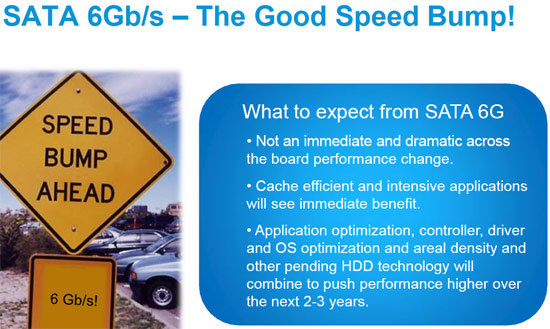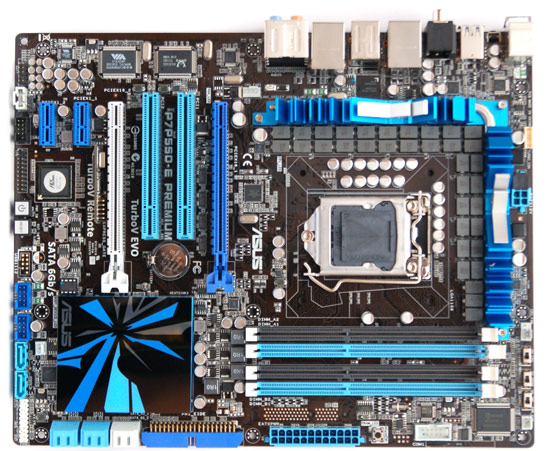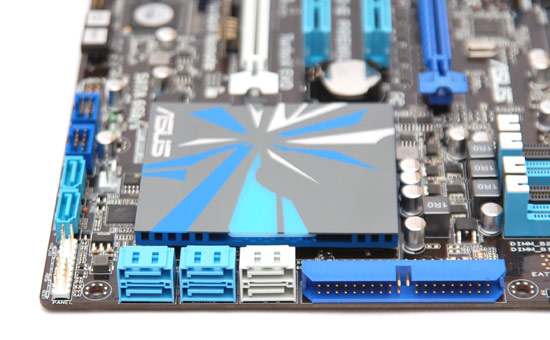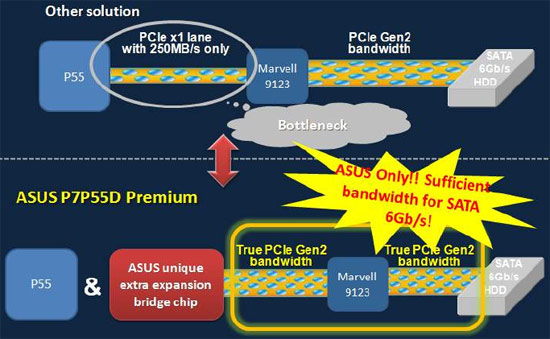Seagate XT 2TB SATA 6Gb/s Hard Drive Testing
SATA 6Gb/s Arrives, But Should You Care?

The Seagate Barracuda XT hard drive is the industrys first drive to support the new SATA 3.0 specification, which supports speeds up to 6Gb/s (Gigabits per second). To achieve speeds that exploit the new SATA 6Gb/s bus, your system must include a compatible SATA 3.0 compliant controller. At this time there are two companies with SATA 3.0 equipped mother boards on the market: Gigabyte and AsusTek.

What should you expect from SATA 6G? Well according to the marketing slides that Seagate provided to us, nothing too earth shattering. They mentioned that there would be no immediate and dramatic across the board performance change, which is what we as enthusiasts love to see. Only cache efficient and intensive applications should see an immediate benefit from SATA 6G. This is only the birth of SATA 6G, so expect it to get much better in the next 2-3 years.

The ASUS P7P55D-E Premium (shown above) is the first motherboard on the market to offer SATA 6Gb/s. ASUS has broken though the chipset limitation and have added a PCI Express bridge chip that doubles the PCI Express bandwidth available for the SATA 6Gb/s controller. This means that youll get true SATA 6Gb/s performance and will be able to reach the kinds of speeds youd expect to see from a SATA 6Gb/s controller. Compared to competing solutions without the bridge chip, youll see in excess of 50% increase in HD Tach Burst Speeds and over 30% performance advantage in the HD Tune Burst Write Speeds.

The two white SATA ports in the picture above are powered by the Marvell 88SE9123 controller and the PLX bridge chip to take full advantage of SATA 6G speeds. In order to reach peak performance we were told to use a SATA 6Gb/s certified hard drive as well as to use the bundled SATA 6Gb/s data cable. The SATA cable doesn’t appear any different, but since the cables come with the board it doesn’t make any sense not to use them.

Before we get to the benchmarks let’s take a look at how the ASUS P7P55D-E Premium motherboard design is better than SATA 6G implementations that used the Marvell 9123 chip a few months ago. The first board with SATA 6G support that we saw was the Gigabyte GA-P55-UD5. That board had the pair of Marvell 9123 controllers interfaced directly to the Intel P55 Express chipset through a single PCIe 1.0 x1 lane – a connection that is limed to just a 250 MB/s data rate. Obviously, this is a data rate that is lower than the 300 MB/s rated specs on SATA II and is nowhere near the 600 MB/s rate that is needed for the SATA 6G standard. A few months ago there was really no way around this because the Marvell 9123 controller only had support for one PCIe x1 lane, and the Intel P55 chipset only offers PCIe 1.0 connections.

Engineers at ASUS came up with a better looking solution that involves
the addition of a PEX PLX8613 PCIe bridge chip onto the motherboard.
The bridge chip allows the Marvell 9123 to connect to the P55 Express
chipset via a single PCIe 2.0 x1 lane for a maximum bandwidth of 500
MB/s. That is still not has high as the 600 MB/s limit of SATA 6G, but
more than twice the performance of the other way of doing it, which was
limited to just 250 MB/s. The PLX chip then connects directly to the Intel P55 chipset
via x4 lanes of PCIe 1.0 that provide as much as a 1 GB/s of bandwidth, which is more than the Marvell 9123 controller can ever handle due to design limitations. Other SATA 6G boards like the Gigabyte P55A series use a Marvell SE9128 SATA 6Gb/s controller without the bridge chip, but we’ll talk more about that solution in a future article as this is already getting pretty darn confusing if you ask us.
Today, we will be taking the ASUS P7P55D Premium motherboard with the Seagate XT 2TB hard drive to test the drive performance of SATA3 6G versus SATA2 to see if we can see a performance difference.

Comments are closed.